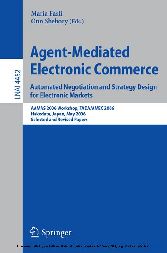Suchen und Finden
Mehr zum Inhalt

Agent-Mediated Electronic Commerce. Automated Negotiation and Strategy Design for Electronic Markets - AAMAS 2006 Workshop, TADA/AMEC 2006, Hakodate, Japan, May 9, 2006
Market Efficiency, Sales Competition, and the Bullwhip Effect in the TAC SCM Tournaments (p. 62-63)
Patrick R. Jordan, Christopher Kiekintveld, Jason Miller, and Michael P. Wellman
University of Michigan
Computer Science & Engineering
Ann Arbor, MI 48109-2121, USA
Abstract. The TAC SCM tournament is moving into its fourth year. In an e.ort to track agent progress, we present a benchmark market efficiency comparison for the tournament, in addition to prior measures of agent competency through customer bidding. Using these benchmarks we find statistically significant increases in intratournament market efficiency, whereas agents are generally decreasing in manufacturer market power. We find that agent market share and bid e.ciency have increased while the variance of average sales prices has been significantly reduced. Additionally, we test for a statistical relationship between agent pro.ts and the bullwhip effect.
1 Introduction
The supply chain management (SCM) game of the Trading Agent Competition (TAC) has provided three years of rich competition among a diverse pool of participants. We seek to evaluate progress and changes in the field of agents, and employ a variety of measures for this evaluation. These include measures of both social welfare and individual performance. We also raise the issue of bullwhip effects in the TAC SCM game, since this is a commonly discussed phenomenon in other supply chain settings. Our analysis is complicated by the strategic interactions that played out in the component procurement markets on day 0 during the early years of competition, and the subsequent changes to the game specification. We will discuss the possible e.ects of these changes at relevant points in the discussion.
In Section 3 we discuss a method for calculating market e.ciency and the division of surplus in the SCM-game. Using this measure of efficiency as a benchmark, we compare agent performance between rounds in each of the three tournaments and note interesting trends between tournaments. Section 4 gives results comparing several measures of sales performance in the customer market. Since the specification of the customer market has changed less drastically than the supply market, comparisons across tournaments on these metrics hold more weight. In Section 5 we apply a basic measure of the bullwhip effect to the SCM market and consider the relationship of this measure with market e.ciency and the division of surplus. We conclude with a summary of the results and discussion of the usefulness of the various measures.
2 TAC SCM Game
The TAC supply chain management game ([1], [2], [3]) consists of six manufacturing agents competing simultaneously in two separate markets over a period of 220 simulated days to assemble and sell PCs to customers. The manufacturing agents attempt to procure processors, motherboards, memory, and hard drives from eight suppliers at low cost, while assembling and selling 16 di.erent types of PCs to customers at a high price. Each agent is assigned an identical factory for production. Factories have a limited number of cycles each day for production. PC types vary in the number of cycles necessary for production.
Supplier prices are determined by available capacity and inventory levels. The available capacity is driven by a mean reverting random walk, while inventory is determined by past excess capacity and orders already on the books. In 2005, a reputation component was added to the supplier pricing equation. An agent’s reputation determines the order in which the agent’s request for quotes will be considered. Lower reputations result in higher price offers. The agent’s reputation is assigned by considering the ratio of requested amounts to actual amounts purchased. If that ratio is within some acceptable range (acceptable purchase ratio) the agent is designated as having a perfect reputation.
Daily customer demand is Poisson distributed about a mean for each market segment. The mean evolves according to a random walk with an evolving trend parameter. Each customer request for quote contains the requested PC type, quantity, due date, reserve price, and penalty amount. An agent receives an order if the agent issues the lowest bid that meets the reserve price. Agents pay the assigned daily penalty if they faily to deliver by the due date.
Alle Preise verstehen sich inklusive der gesetzlichen MwSt.








